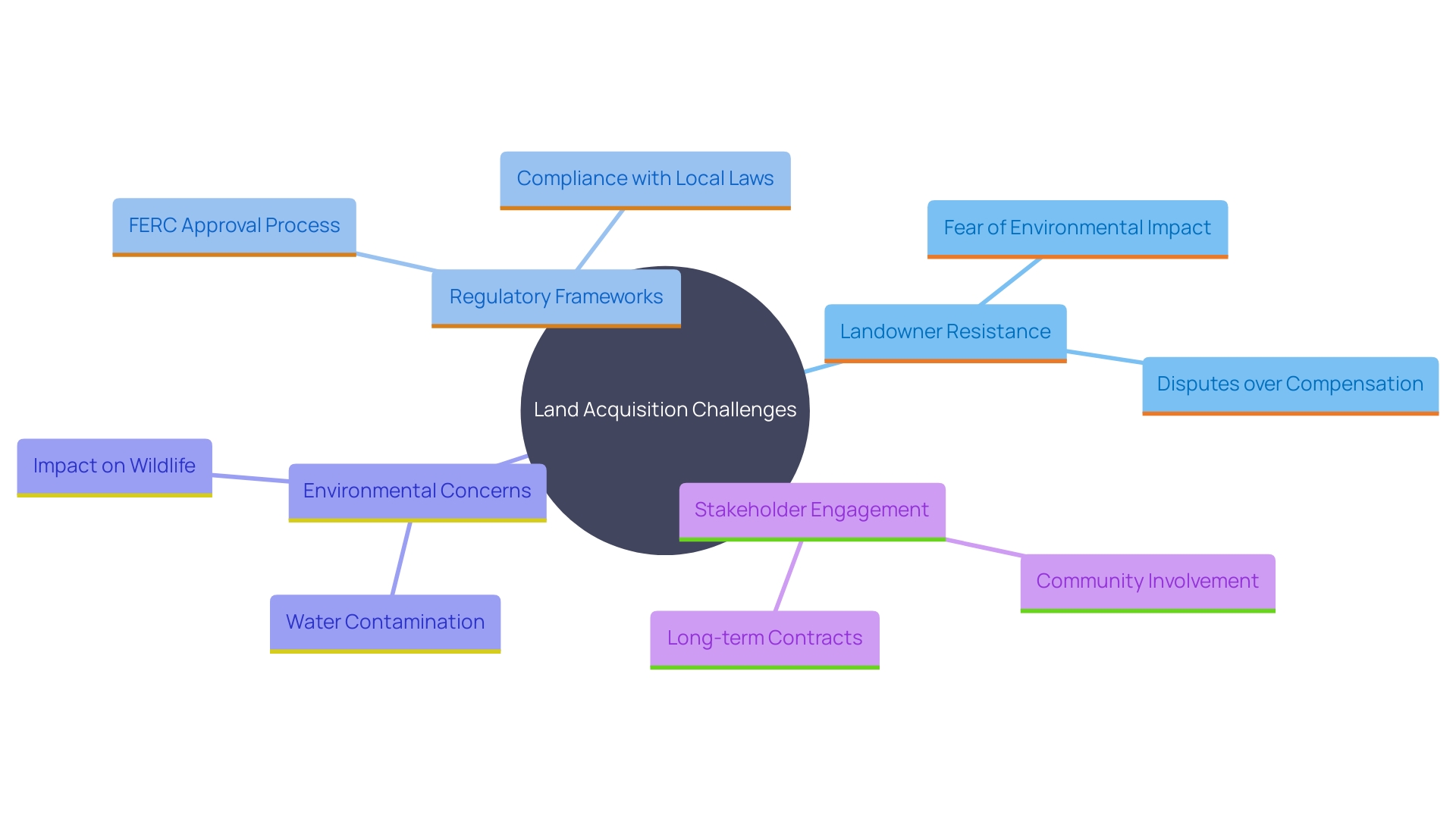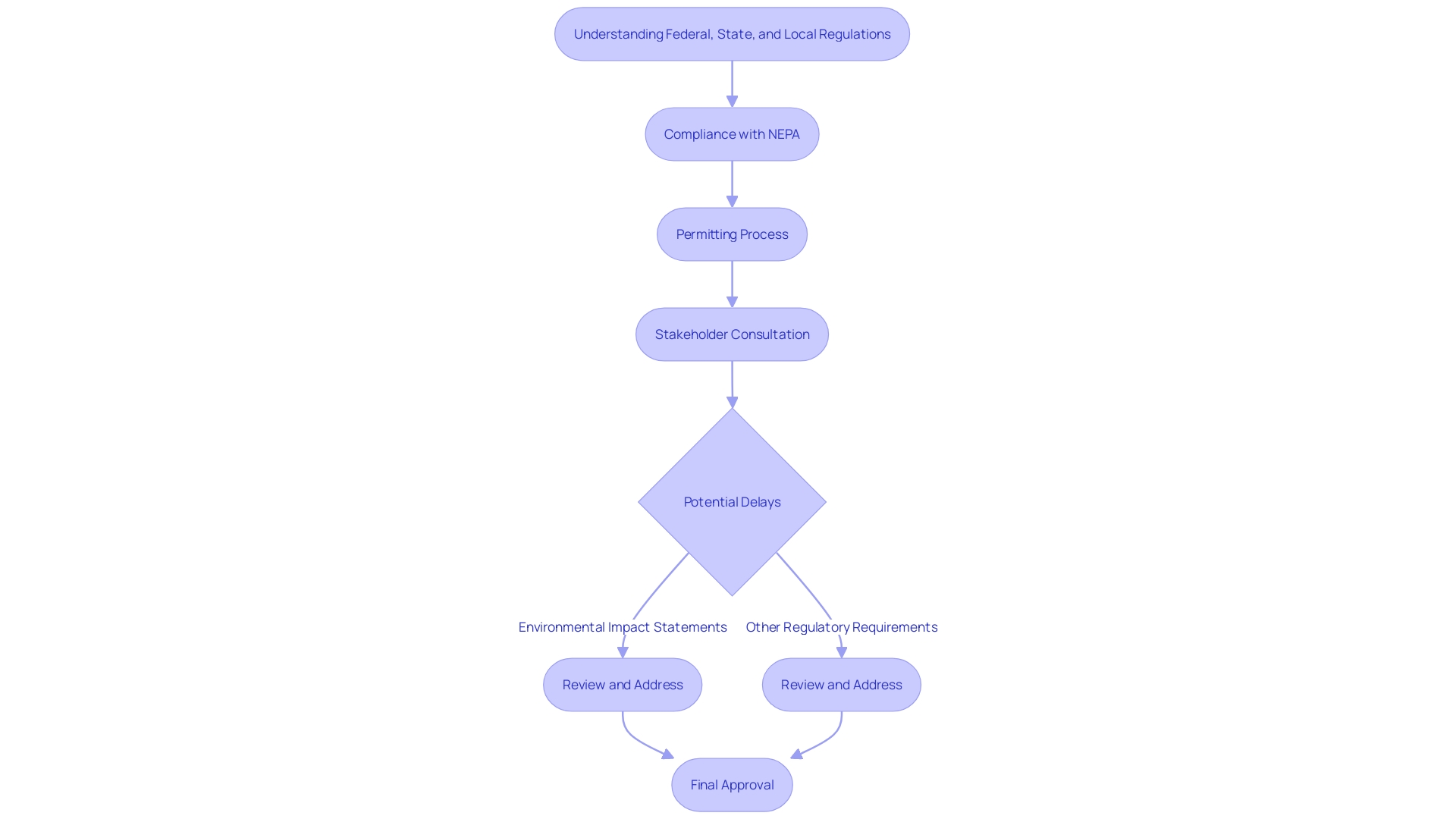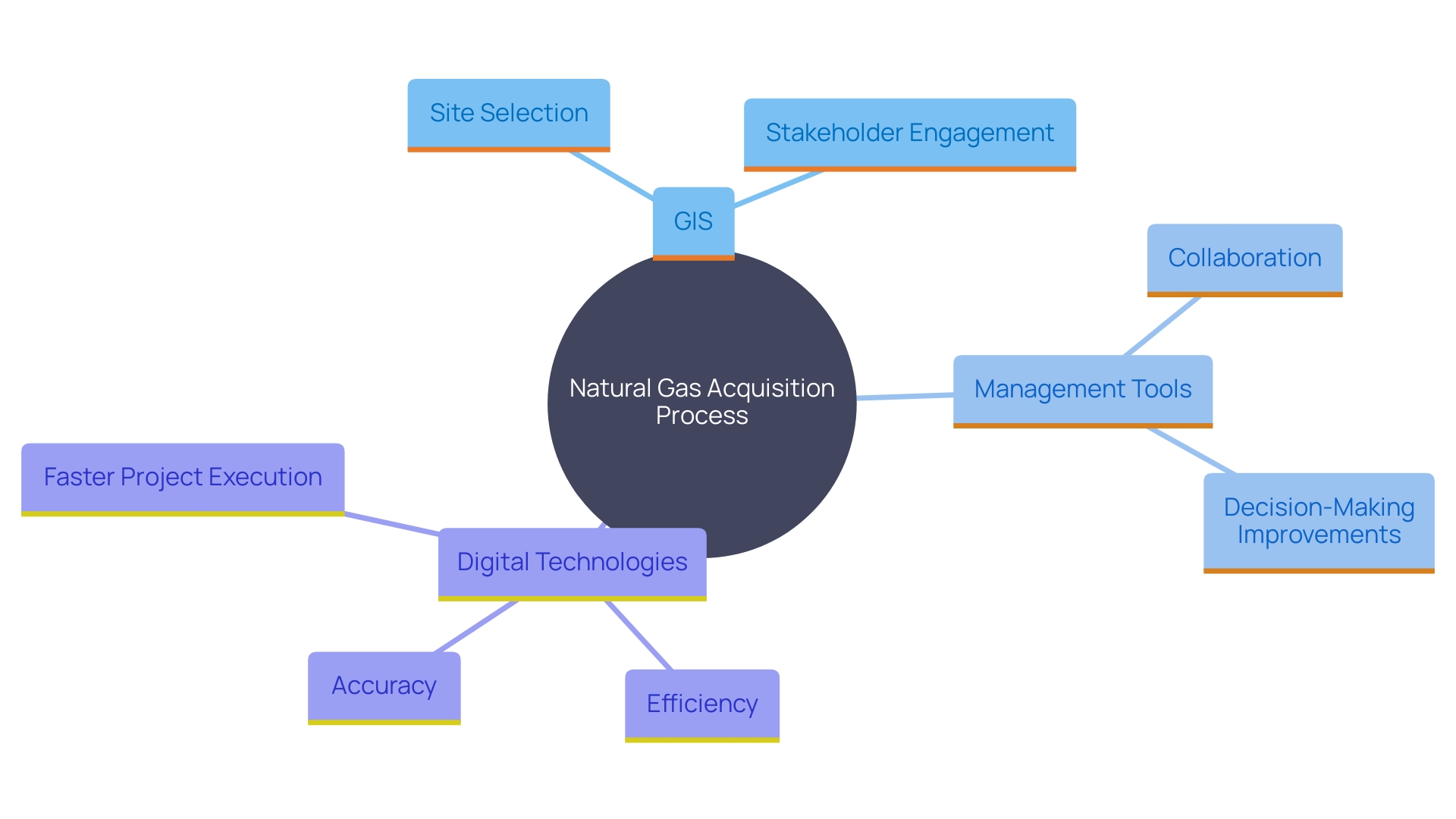Introduction
Acquiring land for natural gas projects presents a complex array of challenges that can significantly impede progress and inflate costs. Key obstacles include landowner resistance, intricate property rights issues, and navigating the multifaceted regulatory frameworks established by entities such as the Federal Energy Regulatory Commission (FERC). Additionally, environmental concerns and public opposition further complicate negotiations, necessitating early identification and resolution of potential issues.
The historical reliance on long-term contracts to demonstrate market demand also introduces tensions between economic and ecological considerations. Understanding these challenges is crucial for developing effective strategies to secure necessary land, fostering transparent communication, and engaging stakeholders proactively to mitigate risks and facilitate smoother project implementation.
Challenges in Land Acquisition for Natural Gas Projects
Obtaining land for natural gas initiatives often presents significant challenges that can hinder progress and inflate costs. Among the primary hurdles are landowner resistance and the intricate nature of property rights. Navigating various regulatory frameworks, such as those established by the Federal Energy Regulatory Commission (FERC), further complicates these efforts. FERC’s rigorous approval process, which includes demonstrating that a project serves community convenience and necessity, underscores the complexity involved.
'Environmental concerns also play a critical role, often leading to community opposition that complicates negotiations with stakeholders.'. For instance, the Federal Energy Regulatory Commission's Office of Public Participation recently held a workshop to facilitate early identification and resolution of potential environmental issues. This initiative emphasizes the significance of community involvement in reducing risks related to land acquisition.
Moreover, the historical reliance on long-term contracts to demonstrate market demand for pipeline initiatives remains a contentious point. These contracts, regulated by FERC, are designed to ensure that private companies only commit to projects with proven public need. However, this practice can sometimes clash with environmental and community interests, demanding a delicate balance between economic and ecological considerations.
Comprehending these complex challenges is crucial for creating effective strategies to acquire the necessary territory. By fostering transparent communication and active stakeholder engagement, it is possible to address these issues proactively, thereby facilitating smoother implementation and reducing associated risks.

Legal and Regulatory Hurdles in Land Acquisition
'Navigating the legal and regulatory environment is a critical aspect of property acquisition for natural gas initiatives.'. This involves understanding federal, state, and local regulations governing land use, environmental protection, and property rights. Compliance with the National Environmental Policy Act (NEPA) and other pertinent legislation is essential to avoid legal pitfalls. The NEPA, initially intended to promote disclosure of impacts, now often adds significant delays and costs to development initiatives. Environmental Impact Statements under NEPA can take more than five years to complete, increasing the complexity and time required for project approval.
Moreover, the permitting process can be arduous and involve extensive documentation and public consultation. The Federal Energy Regulatory Commission (FERC) mandates consultation with stakeholders and the preparation of detailed ecological assessments. These steps, while necessary to ensure robust environmental standards, can slow down timelines significantly. Additionally, state-level regulations, such as the California Environmental Quality Act (CEQA), may further complicate and extend the process.
'The rapid expansion in renewable energy initiatives, including wind, solar, and geothermal, has heightened the need for transmission lines, further contributing to the regulatory burden.'. These initiatives often encounter distinct regulatory hurdles because they do not align seamlessly with current structures created for more established energy sources. Consequently, energy firms must maneuver through a complicated network of regulations and stakeholder interests to effectively obtain property for their endeavors.

Environmental Impact Considerations in Land Acquisition
Environmental impact assessments play a pivotal role in the land acquisition process for natural gas projects. These assessments meticulously evaluate the potential ramifications on local ecosystems, air and water quality, and wildlife habitats. As highlighted by the International Energy Agency’s Net Zero by 2050 Roadmap, incorporating ecological considerations is essential to align with global sustainability goals.
'Stakeholders, including companies and the public, often demand transparency in addressing ecological concerns, which can significantly influence public opinion and regulatory approvals.'. For instance, the Federal Energy Regulatory Commission (FERC) emphasizes the importance of consulting with stakeholders and preparing thorough documents related to nature, such as Impact Statements, during hydropower licensing processes. This collaborative approach ensures that all ecological issues are identified and addressed comprehensively.
Additionally, the increasing demand for renewable energy and the requirement for strong standards in safeguarding frontline communities emphasize the importance of balancing ecological protection with effective permitting. As highlighted by recent news from the World Bank, initiatives like the USD 50 million regional platform aim to fill technical knowledge gaps and support clean energy projects, underscoring the importance of specialized technical support in accelerating energy access.
Successful property acquisition strategies must therefore incorporate comprehensive environmental assessments to mitigate adverse effects and align with sustainability objectives. This approach not only facilitates smoother regulatory approvals but also fosters public trust and supports the broader transition to a cleaner energy economy.

Role of Technology in Land Acquisition: GIS and Project Management Tools
Technology is crucial in enhancing the acquisition process for natural gas initiatives. Geographic Information Systems (GIS) enable teams to visualize and analyze land data comprehensively, aiding in precise site selection and efficient stakeholder engagement. For instance, GIS technology has been instrumental in creating digital twins for urban planning, enhancing our societies and economies by promoting improved ecological practices.
Moreover, management tools significantly enhance collaboration and communication among team members. This enhanced coordination ensures that all facets of the acquisition are meticulously managed, from initial assessments to final negotiations. The state of Minnesota exemplifies the power of mapping technologies, using them to address various societal issues, including infrastructure development and environmental conservation.
Utilizing these advanced technologies not only improves efficiency and accuracy but also speeds up timelines. 'The incorporation of digital tools in extensive agricultural data analysis has already shown significant enhancements in decision-making processes, reinforcing the potential advantages for natural gas initiatives.'. By adopting such innovations, project teams can overcome traditional challenges, ensuring smoother and faster project execution.

Conclusion
Acquiring land for natural gas projects involves navigating a myriad of challenges that can impede progress and drive up costs. Key issues such as landowner resistance, complex property rights, and the intricate regulatory landscape established by entities like the Federal Energy Regulatory Commission (FERC) demand careful consideration. These obstacles are compounded by environmental concerns and public opposition, emphasizing the necessity for early identification and resolution of potential issues.
Legal and regulatory hurdles further complicate the land acquisition process. Compliance with federal, state, and local regulations, particularly the National Environmental Policy Act (NEPA), is critical to mitigate legal risks. The lengthy permitting process, which often requires extensive documentation and stakeholder consultation, can significantly delay project timelines.
Moreover, the rise of renewable energy projects introduces additional regulatory complexities that require careful navigation.
Environmental impact assessments are essential in aligning land acquisition strategies with sustainability goals. Thorough evaluations of potential ecological ramifications not only facilitate smoother regulatory approvals but also foster public trust. Engaging stakeholders transparently helps address critical environmental concerns, ensuring that projects align with community interests and broader environmental objectives.
The incorporation of technology, particularly Geographic Information Systems (GIS) and project management tools, enhances the efficiency of the land acquisition process. These innovations enable precise site selection and improved stakeholder engagement, ultimately streamlining project execution. By leveraging advanced technologies, project teams can effectively address traditional challenges, paving the way for successful natural gas projects that balance economic needs with ecological responsibilities.




